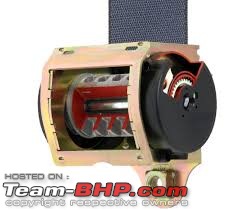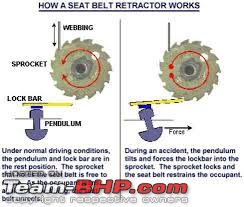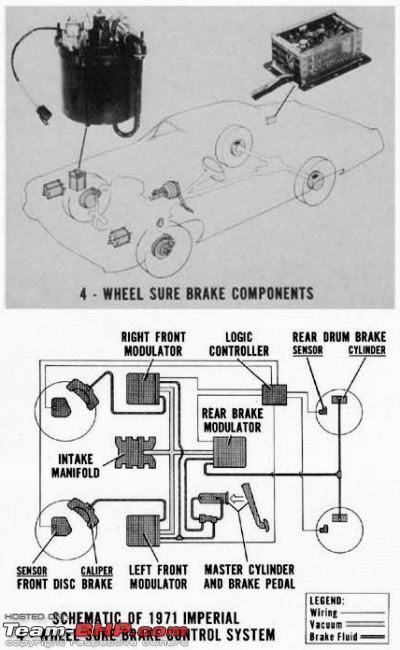| |||||||
| Search Forums |
| Advanced Search |
| Go to Page... |
 |
| Search this Thread |  5,446 views |
| | #1 |
| BHPian Join Date: May 2010 Location: .........
Posts: 682
Thanked: 2,222 Times
| Understanding Car Safety Devices Automobile safety has become a popular topic of discussion on Team Bhp, and justifiably so. India has one of the highest road fatality rates in the world. I have been reading a bit on automobile safety lately. It is a very interesting subject, particularly the history of the development of the devices. I was surprised to know how far the automobile industry has come in terms of prioritizing passenger protection. In this thread, I would like to share the engineering principles behind some of the most innovative devices that make our cars safe. Let us begin with the seatbelt. Seatbelt History and development There is a great thread on three point seat belts started by torquecurve titled Understanding Seat belts: Layman Language where a lot of information about the mathematical derivation of the force experienced by the belt fabric has been depicted. The first seat belt design was patented by Edward J. Claghorn of New York, New York on February 10, 1885. It was a simple device that was meant to fasten a person to a fixed object. The image above shows his design. As we can clearly see, it was similar to a buckle belt (which we wear with trousers) attached with hooks to a fixed object like a seat or a chair. This is essentially the same design that is seen on two point lap belts used in many cars for the rear passengers. The three point Seatbelt arrived much later, in 1959. Nils Bohlin, a Swedish engineer working for Volvo developed the three point seatbelt and patented the invention. This device was deployed for the first time in the Volvo 122 series.   Mechanism Seatbelts have a simple mechanism. There’s a belt that is attached to a spring loaded rotating mechanism that retracts when no pulling force is applied. The picture below depicts this mechanism: The interesting bit is about the way the seat belt locks in place when you try to pull it hard. To understand this process, just look at the following image. Pretensioners In the event of a collision, the seatbelt extension is restricted very quickly by the pretensioners. These devices use a signal from the ECU to trigger a small explosion that pushes a restrictor towards the spindle in the retraction mechanism. The following image is a good illustration of the principle:  This device made its appearance in 1979. The car in which this appeared was the Mercedes C-126 (1981) The Airbag History and Development The invention of the airbag could be considered to be a good example of the manifestation of the proverb “Necessity is the mother of all inventions”. The first airbag was patented by an American gentleman named John W.Hetrick. He patented the device in 1952, but it was not commercially deployable. You can read more about his invention here. The first car that came with airbags was the Oldsmobile Tornado. 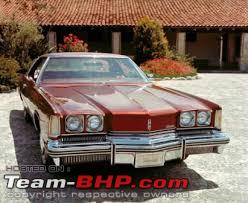 Mechanism The airbag is an example of a simple phenomenon that is complicated by the precision requirements. The basic theme is that a dissociation reaction takes place. The entire setup is something like this: You have a sensor that detects that rapid deceleration of the vehicle in the event of a collision. This sensor then sends this information to the control unit. The ECU sends the signal to the inflation unit- a spark ignites the Sodium Azide that releases the nitrogen gas inflating the cushion. It is important to understand that if the bag remains inflated, the passenger will be injured. There has to be a mechanism to continuously release the gases that are generated. This mechanism is explained by the picture below. The cushion expands in volume and the gas release valve begins to release the nitrogen in the airbag. ABS History and Development It is interesting to note that the concept of antilock braking systems has its origins in 1920’s- for aircraft braking. More details are available here. The first car that came with an ABS was the 1971 Chrysler Crown Imperial. The first car that came with the contemporary ABS was the 1978 Mercedes Benz 116 series of vehicles. There’s an image sourced from this site (www.mercedesclass.net) that depicts the performance of the model with and without ABS. Mechanism In order to understand how the antilock braking system helps you while hard braking, it is important to know why your wheels get locked up. 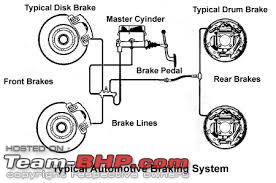 When you press the brake, the fluid from the master cylinder depicted above will create a pressure on the brake shoe (drum brake) and brake caliper (disk brake). We all know Pascal’s law- the pressure will be uniformly distributed. Hence, if the surface that you are driving on is not able to provide traction to the tires, it will arrest the motion of the wheel (which makes the car skid, not roll). This is the basic reason why hard braking at high speeds is dangerous in vehicles without ABS. The same holds true for slippery surfaces. The ABS is a controlling mechanism for the pressure that is applied to each brake. There are sensors that detect the speed of rotation of each wheel. Before the speed approaches zero (the wheel is slipping), the senors give the feedback to the control unit to reduce the pressure on the particular wheel, thus allowing it to roll on. Purpose of this thread We all know how important car safety is. However, the technical details of the devices employed in making cars safer are not always shared by the manufacturers. This thread is a compilation of the basic principles used in the devices- this information can help consumers make better decisions while buying automobiles. It may be stated that the information is available on the internet, but referring to different websites takes time. Simplified explanations for complex devices can be useful. It'll be great if this effort is continued. I'll try to write another post containing the basic details of where research regarding passenger and pedestrian safety is heading. Members with experience in this field can also share their inputs about devices that enhance vehicular safety. The source of information is referenced in the as follows: autoliv.com howstuffworks.com volvoclub.co.uk coloradosuperlawyer.com vinastarmotors.com.vn 4sbccfaculty.sbcc.edu forums.vwvortex.com complete-carworld.blogspot.com mechlover.blogspot.com http://www.hagerty.com/articles-vide...ntilock-Brakes www.curbsideclassic.com http://media.daimler.com/dcmedia/0-9...0-0-0-0-0.html Last edited by GTO : 4th February 2015 at 15:36. Reason: Removing indent tag |
| |  (9)
Thanks (9)
Thanks
|
| The following 9 BHPians Thank Nissan1180 for this useful post: | Ashir, autonarr, dailydriver, GTO, JoseVijay, kutts, Mr.Boss, sourav9385, vb-saan |
| |
| | #2 | |
| BHPian | Re: Understanding Car Safety Devices Quote:
 There can be numerous devices which some of us might be unaware of. Example, ESP, Pedestrian Collision Safety, Impact structural strength, Collapsible mechanisms (of Brake Pedals, Steering Columns), Electric Failure protections, Emergency Exit features, etc Some advance features like auto braking, inter vehicle communications, adaptive headlights, which are still under research. I dont even know much about any of the above but have heard here and there, during internship or while going through NCAP test procedures  It would be great if anyone specialized or otherwise in the field, is able to throw some light on these. | |
| |  ()
Thanks ()
Thanks
|
| | #3 |
| BHPian Join Date: May 2010 Location: .........
Posts: 682
Thanked: 2,222 Times
| Re: Understanding Car Safety Devices There's a wealth of information on the internet. All these stability programs are a great example of the cross functional engineering research. You can create a post about some of the (other) most commonly used safety programs- the ESP, traction control, autonomous braking etc. |
| |  ()
Thanks ()
Thanks
|
 |



